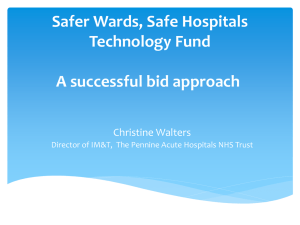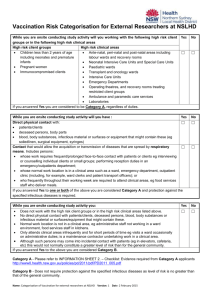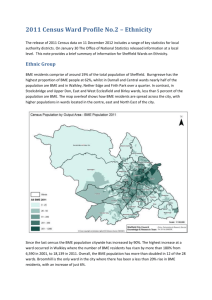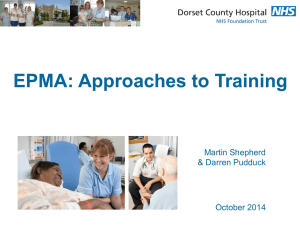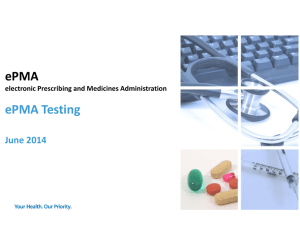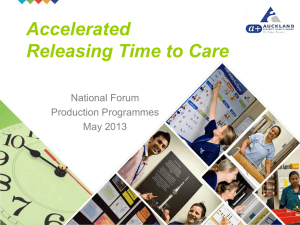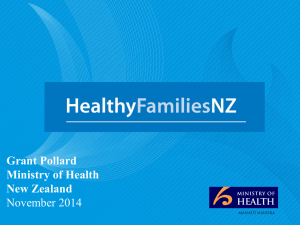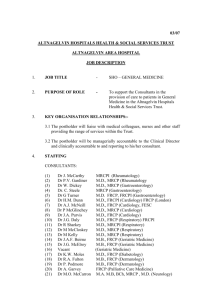ePMA roll-out at Stockport NHS Trust
advertisement
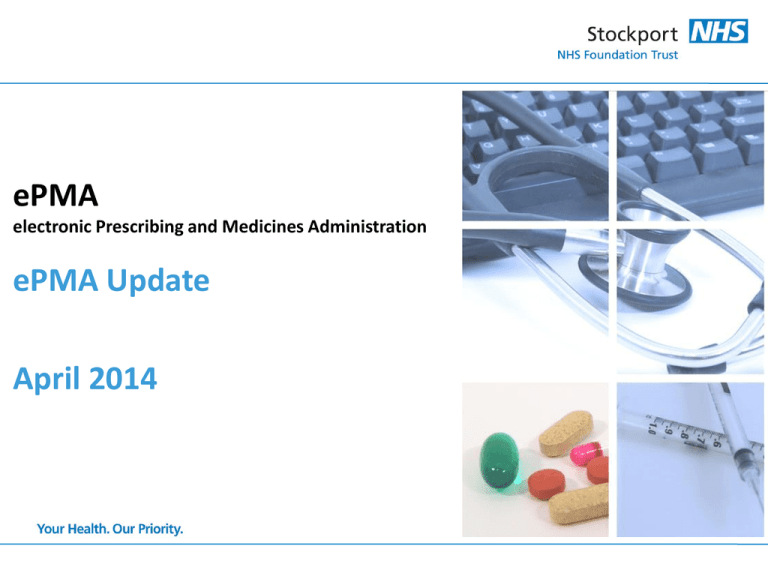
ePMA electronic Prescribing and Medicines Administration ePMA Update April 2014 About Us Stepping Hill Hospital based in Stockport 736 beds Income of £275 million per annum Look after a population of over 396,000 in Stockport & High Peak Over 5,600 staff Go-Live Progress • 38 wards and areas live = 674 beds • ALL adult medical, surgical, orthopaedic, urology, gynaecology & maternity inpatients • Includes all theatres - To date (30.04.2014) 4.2 MILLION doses have been recorded 825,000 pharmacy reviews completed 10,500 clinical reviews completed 30,000 allergy statuses recorded Roll Out Next phases Critical Care Laurel Suite Paediatrics Bluebell Medicine Surgery Womens Critical Care Haematology Paediatrics Project Timeline (2010 to 2014) July 2011 Software demo on Phase 1 wards Decision made to implement Medchart April 2011 Regular project team meetings began 2010 Feb 2012 First training sessions Nov 2011 System build Aug 2011 Initial project board 4 wards July 2012 Dec 2012 3 wards 3 wards Mar 2012 FIRST GO LIVE Oct 2012 3 wards Jan 2013 1 ward 2012 Jan 2012 System testing & sign off June2012 July 2013 14 wards using discharge interface Aug 2013 1 ward 2013 Nov 2012 Feb 2013 June 2013 1 ward 1 ward 5 wards 3 wards Oct 2012 SURGICAL PROCESS MAPPING Feb 2013 First discharge ward Mar 2013 1 ward &2 theatres Tested and upgraded to version 8.1.1 2014 1 ward Sept 2012 May 2011 Baseline data capture & MAIN THEATRES 2 wards 2011 Feb 2011 Initial planning & Phase 1 ward engagement Apr 2013 December 2013 Maternity rollout 3 wards Plans in place for haematology and ICU Investment in Software & Hardware Planning & Preparation Clinical Engagement What has gone well? Project Governance Training Communication User Support Preparation & Planning • Detailed Business Case • Employ/appoint appropriate core team • Base-lining study in medicine 9 months before first go live • System build and configuration • Rigorous system testing • Develop training packages • Ward staff preparation • Training needs analysis • Communication, project information Major Investment in Software and Hardware • Software procurement only after extensive evaluation of different systems • Meets Trust needs and is highly configurable to accommodate changes • Roadmap for future developments • Ability to interface with some existing Trust systems, e.g. PAS • Hardware • Wireless infrastructure • Additional computers • Specially designed drug trolleys • Extra power sockets and locking points Engagement and involvement • Early involvement of nurses and doctors in the project • Nurses and pharmacists invited to comment on drug trolley design, leading to entirely new product • Clinical champions • Medical Consultants • Consultant leads for Anaesthetics, Surgery, Urology and T&O • Engage staff involved prior to each go-live phase • Huge part of our communications plan Project Governance PROJECT BOARD Chair Dr Catania •Director of Information •Consultants from phase 1 wards •IT Programme Manager •Clinical IM&T Project Manager •Pharmacy Project Manager •Assistant Director of Nursing •Principal Pharmacist •Clinical Director of Pharmacy •Supplier reps CSC PROJECT TEAM Chair Helen Bennett Clinical IM&T Project Manager IT Project Nurse Pharmacy Project Manager Assistant Director of Nursing Principal Pharmacist Clinical Director of Pharmacy PAS Manager Supplier reps CSC CORE TEAM Chair Helen Bennett Clinical IM&T Project Manager Pharmacy Project Manager IT Project Nurses IT Trainers Communication Face to face Team Brief Presence on ward Posters Emails Newsletters Intranet news Meetings Microsite Training – tailored to the needs of the user group - - - Nurses • 3 hour classroom based session • Away from ward area • Interactive session with real life examples Prescribers • In house developed interactive eLearning • Can be done at home • Interactive package Other staff groups • Combination of e-learning, 1-1 training and classroom training Super users • New to surgical and T&O wards Supporting the change • Recognise the impact the change has on the ward • Support is provided to all staff for up to 2 weeks • High presence of project team on ward • Particular attention paid to ward nurses • 24/7 help available Downtime Discharge interface – nearly there What hasn’t gone so well? Some hardware issues Transcription Feedback • Doctor “I felt I could use the system straight away following the training, its an intuitive system” • Nurse “Using ePMA is minimising our risk of drug errors, I can easily read what is prescribed which is a huge improvement from paper charts. It is great that all the record is in 1 place rather than having multiple charts, which were often messy and falling apart.” • Pharmacist “ePMA has made it easier to prioritise work and I can work through the list of jobs for the day easily. I find it quicker to perform smaller jobs as I’m not looking for the charts” How have we made sure that ePMA is here to stay? Ensuring ePMA is here to stay • Never promoted as an ‘IT’ project • Clinical system, managed by clinical staff • Success of medical rollout has helped embed in surgical areas • Clinical champions promoting the system • Supporting the change so intensively has ensured we have all staff on board • No going back – the wards do not want to see paper prescriptions again - “don’t take ePMA away!” Thank you
